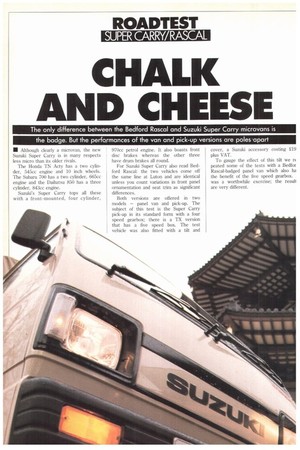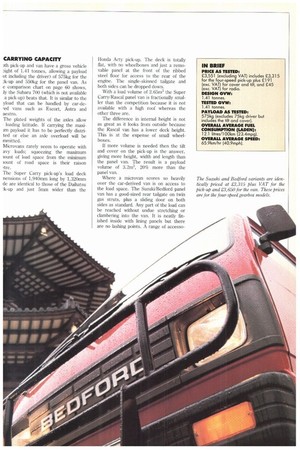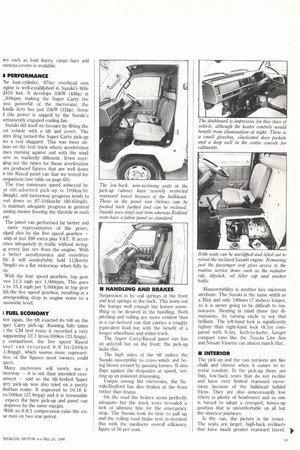CHALK
Page 64

Page 65

Page 67

Page 68

If you've noticed an error in this article please click here to report it so we can fix it.
AND CHEFS
The only difference between the Bedford Rascal and Suzuki Super Carry microvans is the badge. But the performances of the van and pick-up versions are poles apart
• Although clearly a tnicrovan, the new Suzuki Super Carry is in many respects less micro than its older rivals.
The Honda TN Acty has a two cylinder, 545cc engine and 10 inch wheels. The Subaru 700 has a two cylinder, 665cc engine and the Daihatsu 850 has a three cylinder, 843cc engine.
Suzuki's Super Carry tops all these with a front-mounted, four cylinder,
970cc petrol engine. It also boasts front disc brakes whereas the other three have drum brakes all round.
For Suzuki Super Carry also read Bedford Rascal: the two vehicles come off the same line at Luton and are identical unless you count variations in front panel ornamentation and seat trim as significant differences.
Both versions are offered in two models — panel van and pick-up. The subject of this test is the Super Carry pick-up in its standard form with a four speed gearbox; there is a TX version that has a five speed box. The test vehicle was also fitted with a tilt and
cover, a Suzuki accessory costing /19 plus VAT.
To gauge the effect of this tilt we rt peated some of the tests with a Bedfor Rascal-badged panel van which also ha the benefit of the five speed gearbox. was a worthwhile exercise; the result are very different.
CARRYING CAPACITY Ali pick-up and van have a gross vehicle 2ight of 1.41 tonnes, allowing a payload ot including the driver) of 575kg for the 1-up and 550kg for the panel van. As e comparison chart on page 60 shows, Lly the Subaru 700 (which is not available a pick-up) beats that. It is similar to the yload that can be handled by car-dered vans such as Escort, Astra and aestro.
The plated weights of the axles allow loading latitude. if carrying the maxiim payload it has to be perfectly distrited or else an axle overload will be mmitted.
Microvans rarely seem to operate with avy loads; squeezing the maximum iount of load space from the minimum bunt of road space is their raison The Super Carry pick-up's load deck nensions of 1,940mm long by 1,320mm de are identical to those of the Daihatsu .1-up and just 5nun wider than the Honda Arty pick-up. The deck is totally flat, with no wheelboxes and just a removable panel at the front of the ribbed steel floor for access to the rear of the engine. The single-skinned tailgate and both sides can be dropped down.
With a load volume of 2.65m3 the Super Carry/Rascal panel van is fractionally smaller than the competition because it is not available with a high roof whereas the other three are.
The difference in internal height is not as great as it looks from outside because the Rascal van has a lower deck height. This is at the expense of small wheelboxes.
If more volume is needed then the tilt and cover on the pick-up is the answer, giving more height, width and length than the panel van. The result is a payload volume of 3.2m3, 20% more than the panel van.
Where a microvan scores so heavily over the car-derived van is on access to the load space. The Suzuki/Bedford panel van has a good-sized rear tailgate on twin gas struts, plus a sliding door on both sides as standard. Any part of the load can be reached without undue stretching or clambering into the van. It is neatly finished inside with lining panels but there are no lashing points. A range of accesso ies such as load liners, cargo bars and onneau covers is available.
1 PERFORMANCE
'he tour-cylinder, 970cc overhead cam ngine is well-established in Suzuki's little :1410 4x4. It develops 33kW (44hp) at ,300rpm, making the Super Carry the lost powerful of the microvans; the londa Acty has just 23kW (31hp). Some I this power is sapped by the Suzuki's ermanently engaged cooling fan.
Suzuki did itself no favours by fitting the ?.st vehicle with a tilt and cover. The xtra drag turned the Super Carry pick-up ito a real sluggard. This was most ohbus on the test track where acceleration mes running against and with the wind rere so markedly different. Even averging out the times for these acceleration ins produced figures that are well down n the Rascal panel van that we tested for omparison (see table on page 60).
The true maximum speed achieved by be tilt-adorned pick-up is 109km/hr 58mph), and motorway progress tends to wet down to 97-1041unthr (60-65mph). 'o maintain adequate progress in general inning means flooring the throttle in each ear.
The panel van performed far better and more representative of the genre, elped also by the five speed gearbox — snip at just 260 extra plus VAT. It accelrates adequately in traffic without wringig every last rev from the engine. With s better aerodynamics and overdrive fth it will comfortably hold 112km/hr 'Omph) on a flat motorway when fully lam.
With the four speed gearbox, top gear ves 12.3 mph per 1,000rpm. This goes 3 to 15.4 mph per 1,000rpm in top gear ith the five speed gearbox, resulting in a Eresponding drop in engine noise to a rasonable level.
I FUEL ECONOMY
nce again, the tilt exacted its toll on the iper Carry pick-up. Running fully laden the CM test route it recorded a very sappointing 12.1 litres/100km (23.4mpg). y comparison, the five speed Rascal inel van returned 8.9 lit/1 00km 1.8mpg), which seems more representive of the figures most owners could rpect.
Many microvans will rarely see a otorway — it is not their intended enviarnent — and so the tilt-bodied Super 3ri-y pick-up was also tried on a purely iburban route. It improved to 10.16 lies/1001un (27.8mpg) and it is reasonable expect the bare pick-up and panel van improve by the same margin.
With an 8.8;1 compression ratio the enne runs on two star petrol.
• HANDLING AND BRAKES Suspension is by coil springs at the front and leaf springs at the back. This irons out the bumps well enough but leaves something to be desired in the handling. Both pitching and rolling are more evident than in a car-derived van that carries a roughly equivalent load but with the benefit of a longer wheelbase and wider track.
The Super Carry/Rascal panel van has an anti-roll bar on the front; the pick-up lacks this.
The high sides of the tilt makes the Suzuki susceptible to cross-winds and being blown around by passing lorries. It also flaps against the dropsides at speed, setting up an insistent drumming.
Unique among the microvans, the Suzuki/Bedford has disc brakes at the front rather than drums.
On the road the brakes seem perfectly adequate but the track tests revealed a lack of ultimate bite for the emergency stop. The Suzuki took its time to pull up and the rolling road brake test re-iterated this with the mediocre overall efficiency figure of 56 per cent. Manouvrability is another key microvan attribute. The Suzuki is the same width as a Mini and only 180mm (7 inches) longer, so it is never going to be difficult to manoeuvre. Bearing in mind those tiny dimensions, its turning circle is not that brilliant. The left-hand lock is significantly tighter than right-hand lock (8.1m compared with 9_5m, kerb-to-kerb). Larger compact vans like the Toyota Lite Ace and Nissan Vanette can almost match that.
• INFERIOR
The pick-up and the van versions are like chalk and cheese when it comes to interior comfort. In the pick-up there are thin, low-back seats that do not recline and have very limited rearward movement because of the bulkhead behind them. They are also unnecessarily low (there is plenty of headroom) and so one is forced to adopt a cramped, knees-up position that is uncomfortable on all but the shortest journeys.
In the van, the picture is far rosier. The seats are larger, high-back recliners that have much greater rearward travel. They allow people of 1.8m (6ft) plus to sit in acceptable comfort. The seat trim is vinyl in the Suzuki Super Carry but twill cloth in the identically-priced Bedford Rascal.
The dashboard is attractive and the equipment level fairly good for a low-cost van. Even the base Super Carry model has a cigar lighter and three speed fan; the radio is an extra.
Paying an extra £160 plus VAT buys the TX version of the Super Carry panel van, giving the five speed gearbox and heated rear window with wash/wipe.
The stubby little gear lever has a welldefined gate and the change is good. The combination of the centre console, gear lever and near-vertical park brake lever prohibits movement across the cab but this is excusable when one considers the packaging that has to be done to squeeze so much out of so small a vehicle.
Both the front seats can be lifted right out of the pick-up — they tip back in the panel van — for access to the engine beneath them. The spark plugs are a little awkward because they are on the downward-facing side of the inclined engine. The oil filter is best reached from below and the distributor (which retains contact breaker points) is accessible via a panel in the load deck.
There is a manual choke (no warning light) and both the Super Carry and the Rascal we tested were reluctant to start without it.
• SUMMARY
Put against the other microvans, the Super Carry looks attractive. It has a superior mechanical specification and hence better performance. It offers a good payload and comparable load volume. It is also nicely finished (ours suffered only from a bad door shut-line) and wellequipped.
The tilt body is to be avoided at all costs unless absolutely necessary; it makes the pick-up slow, thirsty and noisy. The pick-up also suffers from a poor driving position which cannot be overlooked.
The panel van is a nicer proposition. It is more comfortable and its superb load access is a definite advantage over carderived vans.
The Super Carry is the most expensive of the microvans and while it can justify this price premium, it is also competing the bottom end of the car-derived van market. The Fiat 127-based Fiorino (23,450 plus VAT), the Citroen C15 Visa van (£3,680) and the new Renault Extra (2,680) are possible alternatives, running it close on price, payload capacity and load volume. They also offer more performance, comfort and refinement. The Super Carry/Rascal counters with a more compact, manoeuvrable package that is easier to load and unload.














































































